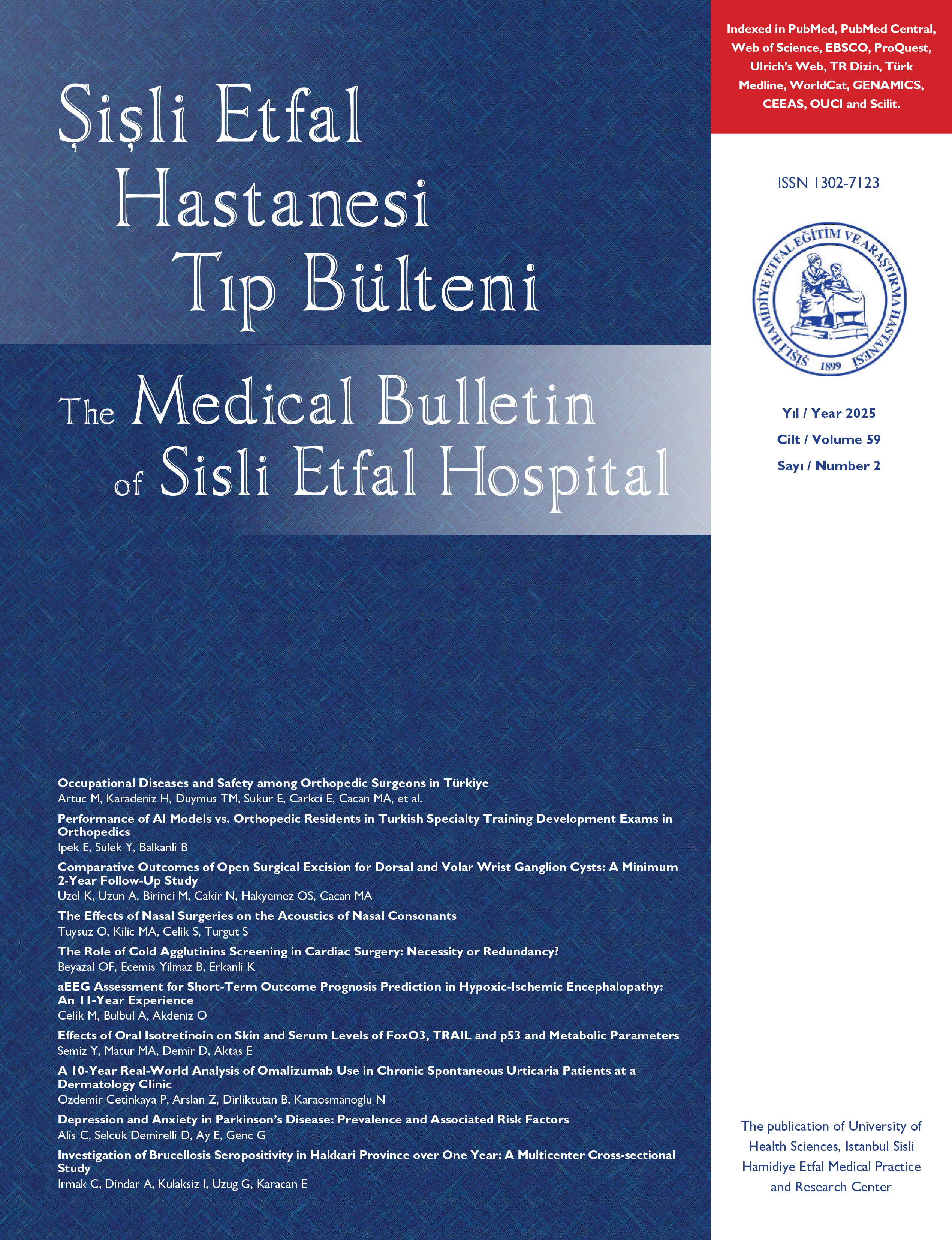
Kraniosinostoz cerrahisinde kan transfüzyonu ve arteriel kan gazı değerleri arasındaki ilişki: Yirmi üç vakalık Retrospektif bir çalışma
Sibel Oba1, Canan Tülay Işıl1, Hacer Şebnem Türk1, Pınar Sayın1, Ferda Aybey1, İnci Paksoy1, Osman Türkmenoğlu2, Adem Yılmaz21Şişli Hamidiye Etfal Eğitim ve Araştırma Hastanesi, Anesteziyoloji ve Reanimasyon Kliniği, İstanbul - Türkiye2Şişli Hamidiye Etfal Eğitim ve Araştırma Hastanesi, Beyin Cerrahisi Kliniği, İstanbul - Türkiye
Amaç: Çocuklarda kraniosinostoz cerrahisi, arteriel kan gazı değişikliklerine bağlı olarak artan miktarda, kan tranfüzyonu gerektirir. Bu çalışmada çocuklarda kraniosinostoz cerrahisinde arteriel kan gazı değişiklikleriyle kan transfüzyonu arasındaki ilişkiyi incelemeyi amaçladık.
Gereç ve Yöntem: Beyin cerrahisi kliniğimizde beş yıl içinde ameliyat edilmiş çocukların verileri retrospektif olarak değerlendirildi. Kraniosinostoz cerrahisi geçirmiş çocukların demografik değerleri, arteriel kan gazı örneklerinin sonuçları, transfüzyon durumları kaydedildi.
Bulgular: 23 olgunun yaş ortalaması 19.00±16.26 ay, olguların %73.9u tek ya da multipl sütürlü düzeltme operasyonu geçirmiş, operasyon süresi 154.13±17.49 dakika idi. 152.63±61.18 mL eritrosit süpansiyonu ve 125.00±57.74 mL taze donmuş plazma transfüzyonu yapılmıştı. Başlangıç ve perioperatif değelerle karşılaştırıldığında, cerrahi sonu HCO3 değeri yükselmiş, baz defisit azalmış, ionize kalsiyum yükselmişti. Preoperatif ve postoperatif hemoglobin değerleri (10.20±1.06/9.91±2.42) değişiklik göstermedi (p=0.583).
Sonuç: Bu retrospektif çalışmadaki veriler, kraniosinostoz cerrahisi geçiren çocuklarda perioperatif ve postoperatif stabil şartların arteriel kan gazı değişiklikleri ile uyumlu kan replasmanına bağlı olduğunu
göstermiştir.
Anahtar Kelimeler: Arteriel kan gazı, kan transfüzyonu, kraniyosinositoz cerrahisi.
The relation between blood transfusion and arterial blood gas values in craniosynostosis surgery: a retrospective study with 23 cases
Sibel Oba1, Canan Tülay Işıl1, Hacer Şebnem Türk1, Pınar Sayın1, Ferda Aybey1, İnci Paksoy1, Osman Türkmenoğlu2, Adem Yılmaz21Şişli Hamidiye Etfal Eğitim ve Araştırma Hastanesi, Anesteziyoloji ve Reanimasyon Kliniği, İstanbul - Türkiye2Şişli Hamidiye Etfal Eğitim ve Araştırma Hastanesi, Beyin Cerrahisi Kliniği, İstanbul - Türkiye
Objective: Craniosynostosis surgery in infants may require increased blood transfusions, leading to arterial blood gas variations. In this study, we aimed to evaluate the relation between blood transfusion and arterial blood gas changes in infants during craniosynostosis surgery.
Material and Methods: Data of all children, who were operated in our neurosurgery clinic during a five-year period were screened retrospectively. Demographics, arterial blood gas sample results, transfusion requirements in children who underwent craniosynostosis surgery were recorded.
Results: The mean age of 23 cases was 19.00±16.26 months, 73.9% of the patients underwent single/ multiple suture correction, and the mean duration of operation was 154.13±17.49 minutes. The mean transfused materials were 152.63±61.18 mL erythrocyte suspension and 125.00±57.74 mL fresh frozen plasma. At the end of the surgery, HCO3 was higher, base deficit was decreased and ionized calcium was higher compared to beginning and perioperative values. Preoperative and postoperative hemoglobin values (10.20±1.06 / 9.91±2.42) showed no difference (p=0.583).
Conclusions: Our data from this retrospective study has confirmed, that in children undergoing craniosynostosis surgery, perioperative and postoperative stable condition is related to adequateblood replacement compatible with arterial blood gas changes.
Keywords: Arterial blood gas, blood transfusion, craniosynostosis surgery.
Makale Dili: Türkçe



















